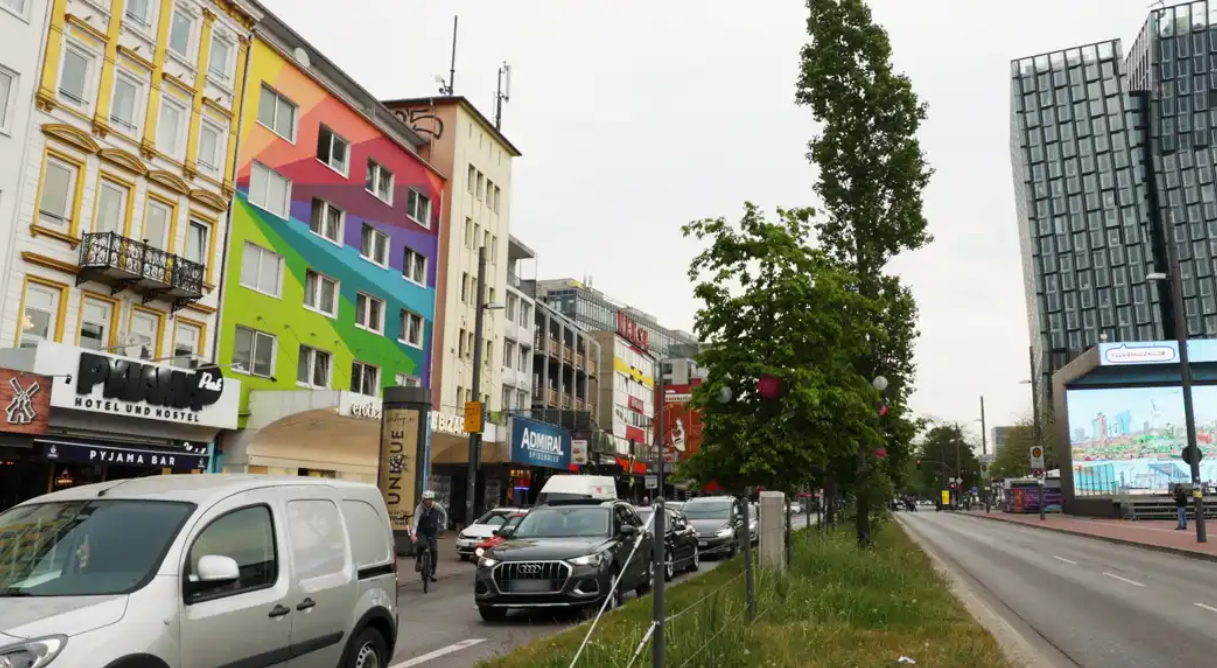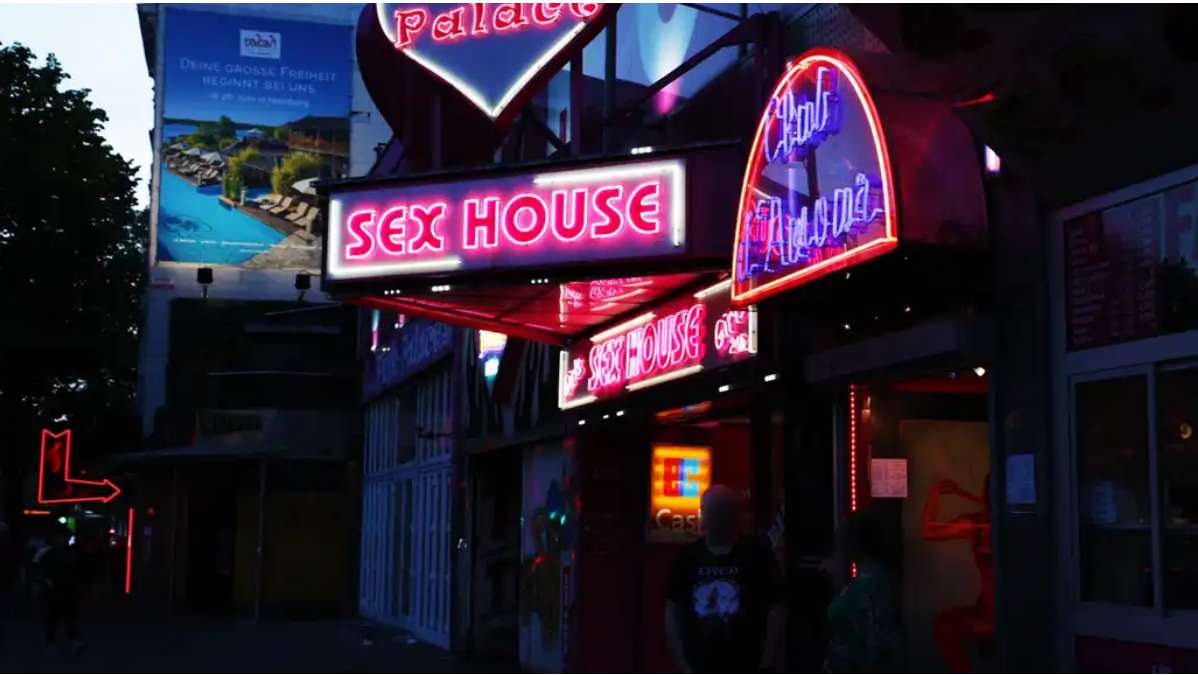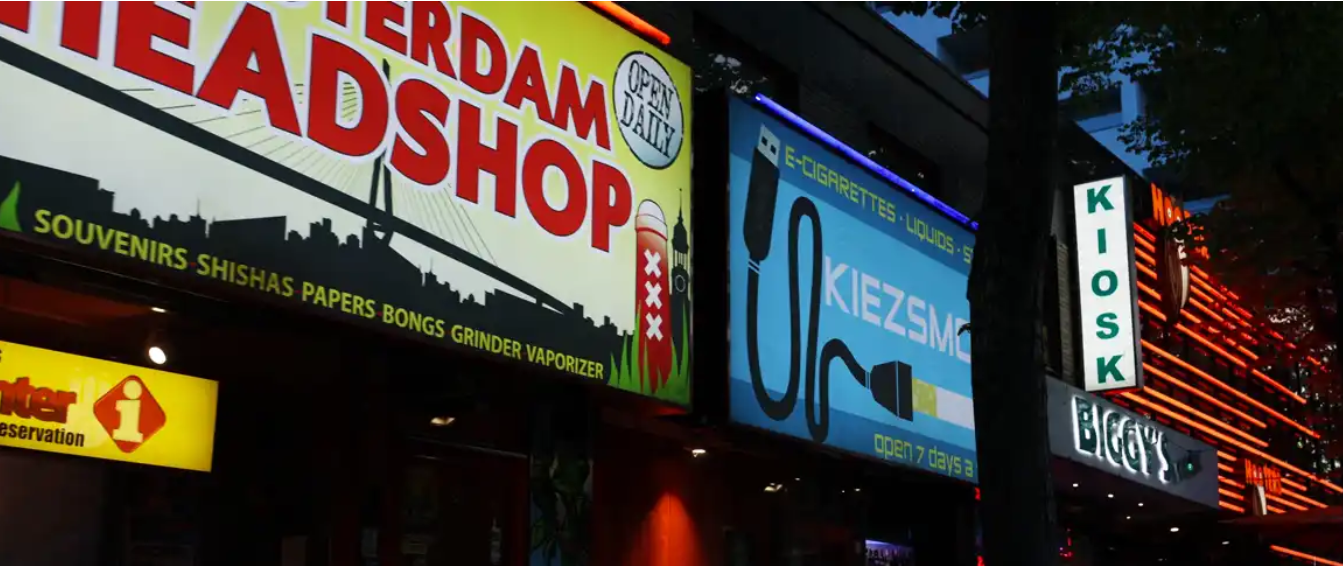Hamburg’s legendary entertainment district, full of life, music, and history
Address: St. Pauli – Hamburg District, Reeperbahn 1, 20359 Hamburg | Named since: c. 1820/30 | Length: 930 meters
The Reeperbahn in Hamburg is much more than just a red-light district or a mile of sin. Located in Hamburg’s St. Pauli district, it is the perfect destination for thousands of party-loving Hamburgers and visitors who want to explore Hamburg on a city trip. Clubs, pubs, bars, and theaters are lined up along the Reeperbahn like pearls on a string. Among the special hotspots, besides Hans-Albers-Platz and Große Freiheit, is Spielbudenplatz, where the theaters and shops cluster. The best way to get an overview is to join a guided walking tour of the Reeperbahn, as there are many sights to discover.
Directions and location of the Hamburg warning sign
Roughly speaking, the neighborhood consists of Große Freiheit, Hamburger Berg, Hans-Albers-Platz, and the Reeperbahn. The Reeperbahn is located in the Hamburg district of St. Pauli, bordering Altona. Millerntorplatz, Helgoländer Allee, and Ring 2 lead directly to the Reeperbahn. The neighborhood is rather quiet during the day, with the occasional café inviting you to linger. As dusk sets in, the entertainment district and adjacent squares and streets come alive. There’s live music in the pubs and trendy clubs. The Reeperbahn also boasts a number of curiosities. Today, it’s hard to imagine that the historic Reeperbahn, just outside Hamburg’s city gates, was a place for outcasts.
Opening Hours and Tours
The Reeperbahn in St. Pauli is open 24 hours a day and can be visited and toured at any time. However, the nightlife only begins at dusk. Anyone who wants to experience the entertainment district in a unique way and with its diverse facets should visit the Reeperbahn during the day and especially at night.

Reeperbahn Entrance Fees
There is no entrance fee to stroll along the Reeperbahn. However, entrance fees are charged at various clubs, bars, pubs with live music, and other must-sees.
Guided Tours of the Reeperbahn
The uniqueness of the Reeperbahn can best be experienced by booking a Reeperbahn tour with well-known personalities. Every neighborhood tour offered is something special, regardless of whether you opt for a comprehensive Reeperbahn tour or a neighborhood tour of the red-light district. There are tours of the Reeperbahn with bouncers, tours with a night tour, walking tours with real Hamburg locals who have extensive insider knowledge, and exclusive neighborhood tours with Olivia Jones, cult neighborhood tours, party neighborhood tours, and those that show the Reeperbahn in its rawest form.
FAQ – Frequently Asked Questions about the Reeperbahn
Where does the name Reeperbahn come from?
Reeperbahn is derived from the rope-makers (Repschläger), who made ropes and cordage in the alleys of St. Pauli. It was advantageous that the port in Hamburg was already a central trading center at the time. This allowed the rope-makers to sell the finished ropes and cordage to sailors.
Since when has the Reeperbahn been known as an entertainment district?
Its development into an entertainment district dates back to the 19th century. St. Pauli was located outside Hamburg’s city limits and was a meeting point for workers, sailors, and traders. Since the area outside the city limits was not as strictly regulated, dance halls, bars, and brothels settled there. This laid the foundation for meeting the needs of this clientele even back then.
What does the term “Kiez” mean in connection with the Reeperbahn?
The entertainment district in St. Pauli, which includes not only the Reeperbahn, but also Herbertstraße, Talstraße, Davidstraße, Große Freiheit, Hans-Albers-Platz, and Hamburger Berg, is known as the Kiez. For Hamburgers, the term means “red-light district.”
What is there to see on the Reeperbahn?
Numerous restaurants, bars, nightclubs, and discotheques are located on the Reeperbahn and its adjacent side streets. Sex shops, brothels, strip clubs, and similar establishments have also settled there.
Is it worth visiting the Reeperbahn during the day?
The Reeperbahn also has a lot to offer during the day. However, the street exudes a completely different atmosphere. There are special places to discover and exciting activities to enjoy. The Reeperbahn is home to the Panoptikum, the Schmidt Theater, and the St. Pauli Theater. There is also a lot of street art to admire in the streets. Cafés and restaurants invite you to linger, serving traditional Hamburg cuisine or a hip brunch. A shopping spree is also worthwhile on the Reeperbahn and its side streets, as there are many unique shops and boutiques offering unique items.
Why does the Davidwache on the Reeperbahn enjoy cult status?
There are several aspects to why the Davidwache enjoys cult status. But strictly speaking, the police station symbolizes an exclusive mix of colorful hustle and bustle and harsh reality that characterize St. Pauli in a special way. The Davidwache also symbolizes the rough yet warm charm that the district exudes.
Reeperbahn – Special Features and Interesting Facts
The Reeperbahn in the St. Pauli district is world-famous and considered the most sinful mile, especially at dusk. Then not only the Reeperbahn, but also the adjacent streets and squares come alive. During the day, it’s rather quiet, and cafés invite you to linger.
The atmosphere of the Reeperbahn at dusk is dominated by neon signs competing for attention. Clubs, bars, and pubs open their doors and offer a diverse program with live music, table dancing, and other attractions. Exuberant partying and dancing are included. The Reeperbahn is packed with people, and unique birds of paradise can be discovered. Where people party today, was once an outcast area outside Hamburg’s city gates.
The Reeperbahn and its side streets have seen a lot. Music history was made in the 1960s when the Beatles performed there for the first time. They performed at Club Indra, which still exists today. The Kaiserkeller also still exists. The famous Star Club no longer exists, but there is a commemorative plaque.
The difference between the Reeperbahn and other nightlife districts with discos and bars is that there are special establishments on the Reeperbahn offering striptease, buresque, table dancing, and erotic entertainment. Reeperbahn landmarks include the Dollhouse, Susi’s Show Bar, and The Bunny Burlesque St. Pauli. Near Davidwache is the infamous Herbertstraße, which has a screen at both ends. Women and minors are not allowed on the brothel street.
In addition to clubs and bars, the Reeperbahn also has variety shows and theaters such as Schmidt’s Tivoli and the Stage Operettenhaus. Since 2012, there has been a unique architectural attraction: the Dancing Towers, with their curved facade, stand at Reeperbahn 1. The towers were designed by Hadi Teherani. They are intended to resemble a tango-dancing couple or a prostitute with knock-knees looking for clients. The construction brought about a significant change in the neighborhood, which has drawn criticism from local residents. The building complex is primarily used as office space. Reeperbahn Radio and the Mojo Club are also located there. Those who venture to the upper floor of the Dancing Towers can enjoy fantastic views of the harbor and the Reeperbahn from Clouds, a restaurant and bar.

Historical Facts and History of the Reeperbahn
The St. Pauli district, officially known as Hamburger Berg until 1833, has a long history dating back to 1247. The first settlement is documented to have existed near today’s fish market. A Cistercian monastery, founded by Countess Heilwig von der Lippe, was located there. She was the wife of Count Adolph IV of Schauenburg and Lippe.
However, the monastery was abandoned around 50 years later for military reasons and due to supply difficulties. In 1429, the mayor’s wife received the area as a gift, which from then on served as a crossing point between the fishing settlement, Altona, and Hamburg.
The Nobistor and Millerntor gates were built at the respective entrances to this area starting in 1621, and a rampart was constructed. Those who could not afford to live behind the fortress wall then settled on Hamburger Berg. These included innkeepers, prostitutes, and entertainment establishments, artisans, businesses, and institutions such as the Pesthof, which were unwelcome to the society behind the city walls.
From 1630 onwards, rope makers and rope-makers also settled there. They needed long lanes to pursue their trade. This work gave the Reeperbahn its name around 1820/30. Entertainment began in the district around the 17th century and continued to expand.
In the 1930s, this led to countless entertainment establishments springing up like mushrooms in the immediate vicinity of the harbor. The red-light district quickly settled there, as international sailors who docked in the port of Hamburg promised wealthy clientele.
Thanks to films by Freddy Quinn and Hans Albers, St. Pauli became world-famous in the 1950s and became synonymous with the easy life. Soon after, visitors to the Free Hanseatic City wanted to enjoy themselves according to the motto “on the Reeperbahn at half past midnight.” People danced at the legendary Café Keese, and real horses could be ridden in the Hippodrome.
The decline of St. Pauli and the Reeperbahn was heralded by prostitution and violence. In the 1970s and 1980s, rival pimp gangs fought out their wares in the streets. In addition to prostitution, receiving stolen goods, arms trafficking, drugs, and violence were commonplace, which destroyed the reputation of St. Pauli and the Reeperbahn.
The murders at the Hamburg police headquarters in 1986 were the culmination of these horrific events. The hitman Pinzner, nicknamed “Mucki,” murdered a public prosecutor and his wife and then committed suicide.
But thanks to the courage of Stage Entertainment GmbH, the tide has turned. Like a “phoenix rising from the ashes,” St. Pauli and the Reeperbahn have gained new splendor and fame, ultimately thanks in part to the musical “Cats,” which established itself in Hamburg. Schmidt’s Tivoli and the Schmidt Theater were opened. Trendy clubs, bars, and discotheques have settled all around and along the Reeperbahn.
Old, rancid, and decaying stalls on Spielbudenplatz were removed, creating an area where events such as the Reeperbahn Festival are regularly held. The “Santa Pauli” Christmas Market and the St. Pauli Flea Market are also held there annually.

Sights and attractions close to the Reeperbahn
If you want to discover something worth seeing, interesting, and bizarre, you don’t even need to leave the Reeperbahn.
A special attraction at Spielbudenplatz is the Panoptikum wax museum. There, on three floors, you can marvel at wax figures of 130 historical figures in magnificent costumes. There are also wax replicas of Hamburg originals and famous stars, including Elvis Presley and Michael Jackson. The section known as medical history is particularly fascinating. The Panoptikum was founded by Friedrich Hermann Faerber in 1879. It is the largest and oldest wax museum in Germany.
“Zur Ritze” is the most famous and oldest pub on the Reeperbahn. Even though it has no windows, the pub exudes a rustic feel. The then landlord, Hanne Kleine, who had once been a boxer for the East German national team in the mid-1970s, set up a boxing ring in the basement. This pub dates back to the era of the original St. Pauli district. The pub provides an exclusive contrast to the newly constructed buildings. A fan of the pub was the actor Jan Fedder, known to many from the series Großstadtrevier, and Olivia Jones.
A club known far beyond the city limits is the Molorow on Spielbudenplatz, where well-known musicians and bands such as Mando Diao, Die Toten Hosen, Wir sind Helden, and other music greats have performed. Due to the danger of collapse, the club, founded in 1990, was forced to close in December 2013 and is located in the former China Lounge at Nobistor until its planned return to Spielbudenplatz.
If you want to immerse yourself in St. Pauli’s nightlife, you should check out the extensive stage programs at the many theaters. Musicals are performed at the Operettenhaus. Those who enjoy cabaret and quirky performances will find an exciting stage program at the Schmidt Theater or Schmidts Tivoli. The St. Pauli Theater, located right next to the Davidwache, is the oldest theater in Germany. Not only the historic building but also the auditorium is a listed building.
If you want to learn more about panic rocker Udo Lindenberg, Panik City, located in the St. Pauli Clubhouse at Spielbudenplatz 21-22, is the place to go. There are exciting tours that explain Udo Lindenberg’s life.
A stroll along the Reeperbahn automatically leads you to the Davidwache, the police station on the Reeperbahn at Spielbudenplatz 31. The Davidwache has gained great fame through film and television.
Cafés and Restaurants Near the Reeperbahn
Both on and around the Reeperbahn, there are numerous restaurants offering a variety of delicacies and regional dishes, ensuring your culinary well-being. After a thorough exploration of the Reeperbahn and the immediate surroundings, you’re sure to work up an appetite.
Clouds – Heaven’s Bar & Kitchen
If you want to enjoy an indescribable view while enjoying delicious food, you should definitely visit Cloudes – Heaven’s Bar & Kitchen, Reeperbahn 1. The menu features sophisticated appetizers, delicious steaks, and tasty cocktails. The chic rooftop bar has a cozy terrace where you can enjoy expansive views over Hamburg in good weather.
Address: Clouds – Heaven’s Bar & Kitchen, Reeperbahn 1, 20359 Hamburg
Bidges & Sons, located at Reeperbahn 7, is a stylish eatery offering vegan pub fare. It also has a café, a rooftop cocktail lounge, and the opportunity to purchase sustainable, eco-friendly clothing. In addition to delicious cocktails and coffee specialties, the menu includes various burger creations, salads, and other vegan dishes.
Address: Bidges & Sons Burger, Reeperbahn 7, 20359 Hamburg
The Reep – Restaurant at the Schmidt Theater, located at Spielbudenplatz 24-25, boasts a chic, tasteful retro ambiance that exudes a special charm. The kitchen serves regional home-style cooking and typical Hamburg dishes. The extensive drinks menu perfectly complements the delicious food.
Address: Reep – Restaurant in the Schmidt Theater, Spielbudenplatz 24-25, 20359 Hamburg
Holy Taco Restaurant
If you’re craving Mexican cuisine, especially tacos, Holy Taco, located at Reeperbahn 77, offers a great selection. The restaurant offers delicious, authentic Mexican food, and in addition to tacos, the menu also includes dishes with chicken or beef. In addition to Mexican and regional beer, wine, and soft drinks, the drinks menu also offers numerous delicious cocktails.
Address: Holy Taco Restaurant, Reeperbahn 77, 20359 Hamburg
The St. Pauli Burger & Noodlehouse, located at Reeperbahn 99, offers its guests generously topped, grilled burgers with French fries. The menu also includes delicious pizzas and various pasta creations, which can be enjoyed in a relaxed atmosphere.
Address: St. Pauli Burger & Noodlehouse, Reeperbahn 99, 20359 Hamburg